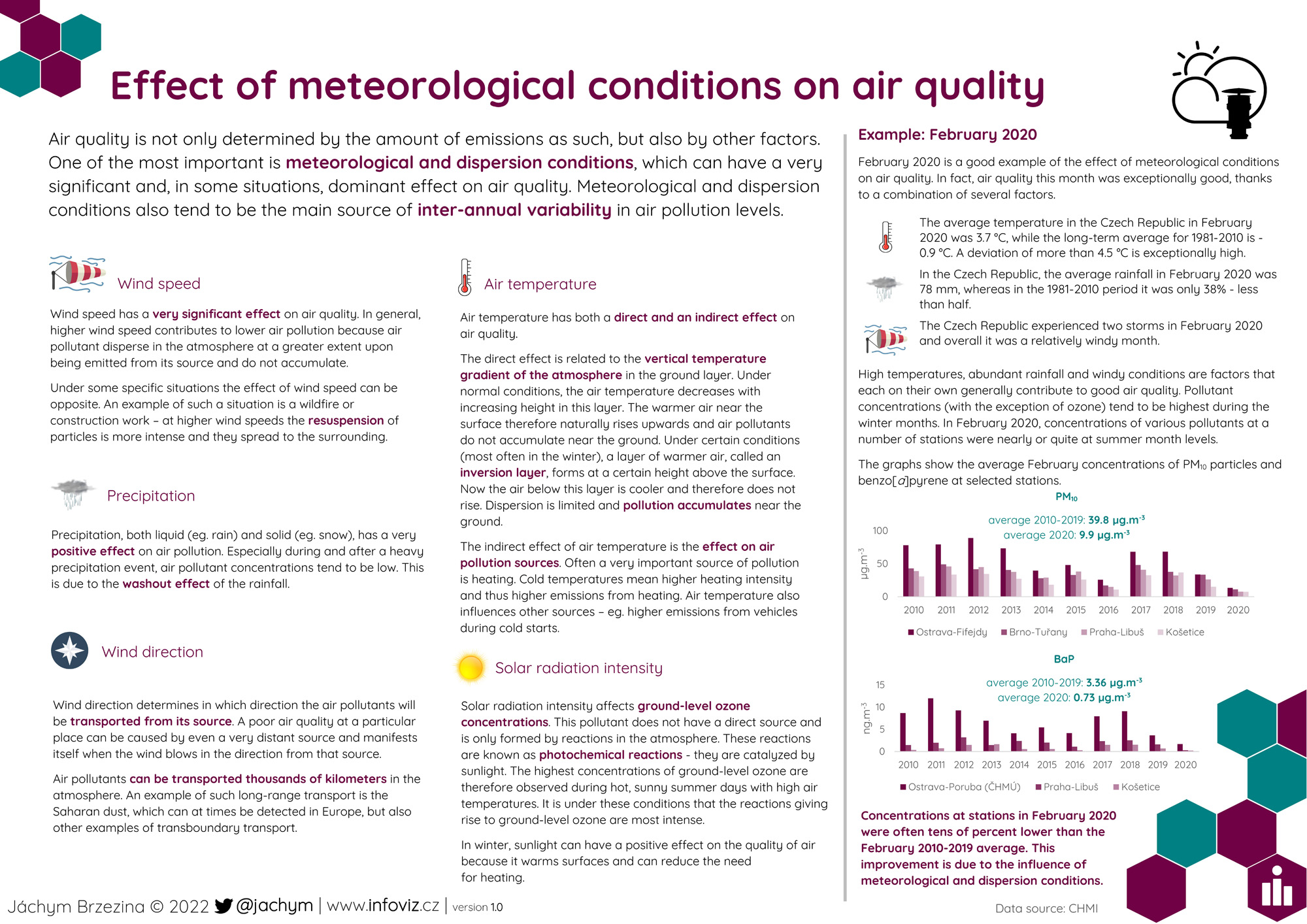
infoviz.cz
Air quality is not only determined by the amount of emissions as such, but also by other factors. One of the most important is meteorological and dispersion conditions, which can have a very significant and, in some situations, dominant effect on air quality. Meteorological and dispersion conditions also tend to be the main source of inter-annual variability in air pollution levels.
Wind speed has a very significant effect on air quality. In general, higher wind speed contributes to lower air pollution because air pollutant disperse in the atmosphere at a greater extent upon being emitted from its source and do not accumulate.
Under some specific situations the effect of wind speed can be opposite. An example of such a situation is a wildfire or construction work – at higher wind speeds the resuspension of particles is more intense and they spread to the surrounding.
Precipitation, both liquid (eg. rain) and solid (eg. snow), has a very positive effect on air pollution. Especially during and after a heavy precipitation event, air pollutant concentrations tend to be low. This is due to the washout effect of the rainfall.
Wind direction determines in which direction the air pollutants will be transported from its source. A poor air quality at a particular place can be caused by even a very distant source and manifests itself when the wind blows in the direction from that source.
Air pollutants can be transported thousands of kilometers in the atmosphere. An example of such long-range transport is the Saharan dust, which can at times be detected in Europe, but also other examples of transboundary transport.
Air temperature has both a direct and an indirect effect on air quality.
The direct effect is related to the vertical temperature gradient of the atmosphere in the ground layer. Under normal conditions, the air temperature decreases with increasing height in this layer. The warmer air near the surface therefore naturally rises upwards and air pollutants do not accumulate near the ground. Under certain conditions (most often in the winter), a layer of warmer air, called an inversion layer, forms at a certain height above the surface. Now the air below this layer is cooler and therefore does not rise. Dispersion is limited and pollution accumulates near the ground.
The indirect effect of air temperature is the effect on air pollution sources. Often a very important source of pollution is heating. Cold temperatures mean higher heating intensity and thus higher emissions from heating. Air temperature also influences other sources – eg. higher emissions from vehicles during cold starts.
Solar radiation intensity affects ground-level ozone concentrations. This pollutant does not have a direct source and is only formed by reactions in the atmosphere. These reactions are known as photochemical reactions - they are catalyzed by sunlight. The highest concentrations of ground-level ozone are therefore observed during hot, sunny summer days with high air temperatures. It is under these conditions that the reactions giving rise to ground-level ozone are most intense.
In winter, sunlight can have a positive effect on the quality of air because it warms surfaces and can reduce the need for heating.
February 2020 is a good example of the effect of meteorological conditions on air quality. In fact, air quality this month was exceptionally good, thanks to a combination of several factors.
High temperatures, abundant rainfall and windy conditions are factors that each on their own generally contribute to good air quality. Pollutant concentrations (with the exception of ozone) tend to be highest during the winter months. In February 2020, concentrations of various pollutants at a number of stations were nearly or quite at summer month levels.
The graphs show the average February concentrations of PM10 particles and benzo[a]pyrene at selected stations.
Concentrations at stations in February 2020 were often tens of percent lower than the February 2010-2019 average. This improvement is due to the influence of meteorological and dispersion conditions.